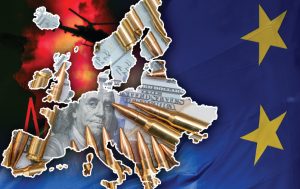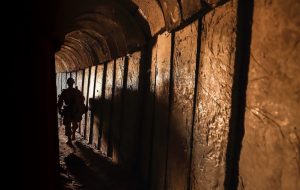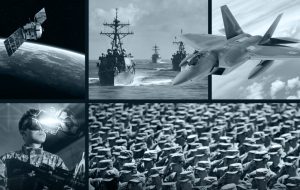On On 17 February 2020 the Federal Authority for Nuclear Regulation (FANR) issued the operating license of the first Baraka Peaceful Nuclear Energy Plants (BPNEP) unit to produce the first megawatt of electricity using nuclear energy, thus making UAE the first Arab nation to produce nuclear energy for development purposes.
His Highness Sheikh Mohammed bin Rashid Al Maktoum, UAE Vice-President, Prime Miniter and Ruler of Dubai, and His Highness Sheikh Mohammed bin Zayed Al Nahyan, Crown Prince of Abu Dhabi and Deputy Supreme Commander of the UAE Armed Forces, highlighted the remarkable implications of this gigantic step. His Highness Sheikh Mohammed bin Zayed Al Nahyan indicated “A new stage of development is hence witnessed after issuing the operating license of the first Baraka Peaceful Nuclear Energy Plants (BPNEP) unit…Our efforts are pursued relentlessly in preparation of the next 50 years and to secure our national energy requirements”.
It is worth-mentioning that UAE peaceful energy program was kick-started in April 2009, and in 2009 the Federal Authority for Nuclear Regulation (FANR) was entrusted with regulating the nuclear sector. The Korean Electric Power Company (KEBCO) was selected as main contractor under an AED 75 billion-worth ($20 billion) contract to build 4 nuclear plants with approved uranium enrichment ranging between 3% and 4% but not exceeding 5%.
Cultural Implications:
1 UAE is placed on top in the Arab and Middle East region by this step, not only as the first nation to produce nuclear energy but also the first with a space program to reach and colonize Mars by 2071. It is the top Arab nation in human development, international competitiveness, women empowerment, caring for the youth, looking to the future, etc.
2 The UAE move encourages the Arab region to use nuclear energy for worry-free development purposes per international safety standards.
3 The step proves that the use of nuclear energy for development purposes is not limited to the advanced nations. Any Arab nation can go down the same road with power, confidence and credibility. This was highlighted by His Highness Sheikh Mohammed bin Rashid Al Maktoum, Vice-President and Ruler of Dubai, in his book “Flashes of Thought” by saying “The impossible is the worst man-made prison, a word invented by the lazy or by those who discourage us to work – a word used by some to put a limit to their ambitions, hopes and aspirations”.
4 The UAE peaceful nuclear program message highlights the fact that nuclear energy can be a means of development rather than of struggle and threat in the Middle East, that solving the hard equation in the region is possible: produce peaceful nuclear energy without triggering world fears of nuclear proliferation.
5 The UAE peaceful nuclear program highlights UAE international credibility and confidence in its policies that support regional and global security and stability. This was translated into high world welcome of UAE nuclear program, notably the International Atomic Energy Agency (IAEA), and many western and eastern nations’ approval to sign nuclear agreements with UAE.
As many as 13 agreements and conventions were signed including IAEA Comprehensive Safeguards Agreement, IAEA Comprehensive Safeguards Agreement Additional Protocol, Convention on Nuclear Safety, the Non-Proliferation of Nuclear Weapons, commonly known as the Non-Proliferation Treaty or NPT, and the Comprehensive Nuclear-Test–Ban Treaty (CTBT) in addition to 123 agreements for peaceful nuclear cooperation with various world countries.
Furthermore, many international testimonials on UAE nuclear program were issued by experts and officials, thus highlighting UAE international credibility. A memo sent in 2009 by the former US President Barack Obama, to his Foreign Secretary on US-UAE cooperation agreement on peaceful use of nuclear energy said “I have gone through the proposed agreement, views, recommendations and feedback of competent authorities and decided that the implementation of this agreement will serve to support joint defence and security and will not pose any incalculable risk”. Hans Blix, IAEA Director General from 1981 to 1997, said “Rationale, determination and commitment to safety standards and non-proliferation, and the economic aspect have been highly effective elements and cornerstones. The project will soon generate a huge amount of electricity to households, industry and transport without any carbon dioxide emissions. It offers a golden standard and affirms my belief that nuclear energy will continue to be a main key to clean and safe electric power”.
6 This nuclear program reflects UAE outlook and readiness to the future. It realizes that sustainable development requirements in future are different from those at present and that oil is a depletable energy that should prompt our readiness for post-oil era by tapping new resources of energy and building a diversified knowledge-based economy. This readiness for post-oil era is a main determinant of UAE’s outlook for the future and of national development plans and strategies in general, an issue frequently raised by His Highness Sheikh Mohammed bin Zayed Al Nahyan, Crown Prince of Abu Dhabi and Deputy Supreme Commander of the UAE Armed Forces, at his meetings with young Emiratis in particular.
UAE Peaceful Nuclear Energy Program A Pressing Development Necessity
The UAE, though an oil and gas-producing country and an OPEC member itself, foresaw the need to diversify sources of energy and look for fresher and cleaner sources. It proved vital and essential for sustainable development for the present and future generations. Taking notice, development plans were drawn accordingly. The UAE nuclear energy program for peaceful purposes carries a development urgency highlighted by profound studies and tight-proof scientific evaluation for the following reasons:
1 Steadily rising population, hence rising need for energy in future. A UK Fitch Solutions report forecast an 8.6% increase in UAE population over the next decade to reach 10.6 million by 2029. This increase should be countered with development plans that suit local demand, especially on energy.
2 Rising population and standard of living means rising need for more water desalination on which the UAE depends for providing drinkable water. About 90% of locally consumed water is provided by desalination plants. Desalination needs more energy and hence more efforts to diversify energy sources.
3 In-depth studies maintain that the UAE will need more energy in future, and that the present energy sources will fall short of local demand over the next decades. This was confirmed by a 2007 study which confirmed that power supply now available will not comply with local demand in future. This demand for power is expected to double by 2020 to 40,000 megawatt.
4 According to The Emirates Nuclear Energy Corporation (ENEC), the UAE opted for nuclear energy to meet future demand for energy in future for a number of reasons; notably that large and fixed quantities of nuclear energy can be generated round-the-clock and all-year around regardless of weather conditions. Nuclear energy can further reduce local carbon dioxide emissions and help UAE diversify, and maximize security of, energy supplies and provide economical, environment-friendly and credible energy to rising local population.
5 Environmental protection is another reason for using nuclear energy for peaceful/development purposes. Estimates indicate that full operation of the four Baraka plants will cut down 21 million tons in carbon dioxide emissions, which equals the removal of 3.2 million vehicles from the roads annually. UAE plans to increase clean energy to 27% of total consumed energy by 202, so as to reach 50% by 2050. The UAE Vision for 2021 agenda provides for 11 crucial indicators; notably quality air, treated waste percentage of total waste produced, clean water contribution, scarce water indicator, etc.
6 Another positive side of UAE nuclear energy program for peaceful/development purposes is to rehabilitate local workforce on nuclear energy. The Emirates Nuclear Energy Corporation (ENEC) offered Emirati students scholarships at prestigious universities in and outside of the UAE, advanced training ships and job opportunities to outstanding Emiratis who currently represent 60% of total workforce.
This trend is customarily encouraged by His Highness Sheikh Mohammed bin Zayed Al Nahyan, Crown Prince of Abu Dhabi and Deputy Supreme Commander of the UAE Armed Forces, who received in November 2019 the first batch of Emiratis who were licensed by Federal Authority for Nuclear Regulation (FANR) as nuclear plant operation managers/operators. His Highness expressed his confidence in Emiratis’ ability to develop Baraka Peaceful Nuclear Energy Plants (BPNEP) as a role model for newer nuclear energy projects world-wide.
7 The development-based UAE nuclear energy falls within a larger master plan for energy in future; namely the Energy Strategy up to 2050 which was launched in 2017to increase clean energy quota of total energy produced from 25% to 50%. It provides an energy mix as follows: 44% of clean energy, 38% of gas, 12% of clean coal and 6% of nuclear energy.
8 Public Support: A 2018 survey by Nielsen, a global measurement and data analytics company, showed that 82% of Emirati respondents supported the use of nuclear power for peaceful purposes to produce electricity, while 91% acknowledged the vital role this energy can play to support UAE march for development and prosperity.
ENEC’s CEO has outlined four elements of the UAE nuclear program; namely the economic element which puts properly managed nuclear energy plants among the most effective sources of power; the environmental element where carbon dioxide emissions are eliminated; secure supplies (where nuclear power plants are highly ready to work (90%); and industrial development where fresh industries and high-value job opportunities are introduced, thus supporting sustainable economic development UAE-wide.
Development-based Nuclear Energy a World trend
An in-depth study was conducted by the UAE to study nuclear energy throughout the world and its share in the world energy mix in future. The following remarks were noted:
1 With nuclear and renewable energy in place, the UAE hopes to cope with world trend, as fossil fuel (oil and gas) share of world energy mix is steadily shrinking. Enter renewable and clean energy as a crucial alternative to fossil fuel. A July 2016 Bloomberg report maintained that renewable energy sources will attract US 7.8 trillion-worth investments by 2040. A “World Energy Prospects” report issued by the International Energy Agency (IEA) in 2017 argued that the rapid use of clean energy technologies has reduced the costs of new solar power facilities by 70%, wind power by 25% and batteries by 40%, and that by 2040 the renewable energy sources will account for 75% of world investments in power generation plants. A latter report in 2018 predicted that renewable energy sector will lead growth in electric power generation by 64% in 2050.
2 Opting for a development-oriented nuclear program meant, by no means, that the UAE is taking an opposite direction of world trend, as “approximately 440 nuclear power stations are currently under operation in 30 countries and another 60 ones are under construction in 15 countries”.
According to World Nuclear Association, some 17 world countries are top users of nuclear plants in power generation; namely US (100 nuclear reactors), France (58), Japan (50), Russia (33), South Korea (23), Canada (20), India (20), UK (18), China (17), Ukraine (15), Germany (9), Spain (8), Sweden )10), Belgium (7), Czech Republic (6) and Switzerland (5).
Middle East and Arab region-wise, there are many programs and plans to produce development-oriented nuclear power in many nations including Saudi Arabia, Jordan and Egypt, while Morocco, Tunisia and Algeria are still studying their options.
In February 2020 the International Atomic Energy Agency (IAEA) reported 28 new nations as currently considering plans to increase dependence on nuclear power, and that they will play a leading role in world shift to clear energy.
Development-oriented UAE Nuclear Program: World Principles/Standards
The UAE has been committed to the standards that highlight the peaceful, as well as the secure, nature of its nuclear program. An April 2008 UAE document was issued on “policy pursued to evaluate and develop a local peaceful nuclear energy program”. Six basic elements were highlighted:
Full operation transparency
Highest nuclear non-proliferation standards
Highest safety and security standards
Direct coordination with the International Atomic Energy Agency (IAEA) and commitment to relevant standards
Build partnerships with the responsible governments and experienced organizations
Secure long-term sustainable nuclear energy
These cornerstones revolve around safe program development, nuclear non-proliferation and refrain from local uranium fertilization or nuclear fuel re-processing.
To comply with maximum safety precautions, utmost scrutiny was exercised when selecting Baraka nuclear plant site in Abu Dhabi’s Al Dhafra to the south west of Al Ruwais 53 kilometers away. The selection, which was anything but haphazard, was based on environmentally-related objective and technical grounds. The Emirates Nuclear Energy Corporation (ENEC) affirmed that this selection was based on “favorable conditions in terms of security, construction, evacuation techniques, proximity to water resources and electricity network”. Also taken into consideration are the standards related to “region seismic history, distance from large densely populated areas, proximity to industry and transport-related infrastructure and the ability to control projected ecological impact”.
In addition, several steps have been taken by the UAE to enhance the security of its nuclear program and highlight its peaceful nature; namely:
1. Establish the Federal Authority for Nuclear Regulation (FANR) as an independent agency to supervise nuclear safety, security, protection against nuclear emissions, guarantees and apply the highest international standards and practices.
2. Establish the International Advisory Council (IAC) to make independent evaluation of the UAE peaceful nuclear program and report directly to UAE higher chain of command. IAC was set up to provide this program with elite international experts with long experience in nuclear safety and security, non-proliferation and human resources development.
3. Nuclear Safety Review Council (NSRC) which was established by the Emirates Nuclear Energy Corporation (ENEC) in July 2010 to make an independent review of safety and efficiency during the establishment and operation stages of Baraka nuclear power plant.
4. In addition, close cooperation was developed with the International Atomic Energy Agency (IAEA) whose experts paid several visits to the UAE to evaluate the main components of the peaceful nuclear program. Cooperation is also maintained with the World Association of Nuclear Operators (WANO) to upgrade nuclear safety levels worldwide. Moreover, the Emirates Nuclear Energy Corporation is a regular participant in workshops, events, training programs and WANO peer review meetings.
Accordingly, in February 2015 the Emirates Nuclear Energy Corporation won first place of the 2015 Risk Management Award issued by UK-based Institute of Risk Management (IRM).
In November 2016 the IAEA-formed International Physical Protection Advisory Service (IPPAS) mission assists States, upon request, in strengthening their national nuclear security regimes, systems and measures.
IPPAS, created by the IAEA in 1995, provides peer advice on implementing international instruments and Agency guidance on the protection of nuclear and other radioactive material, associated facilities and associated activities.













